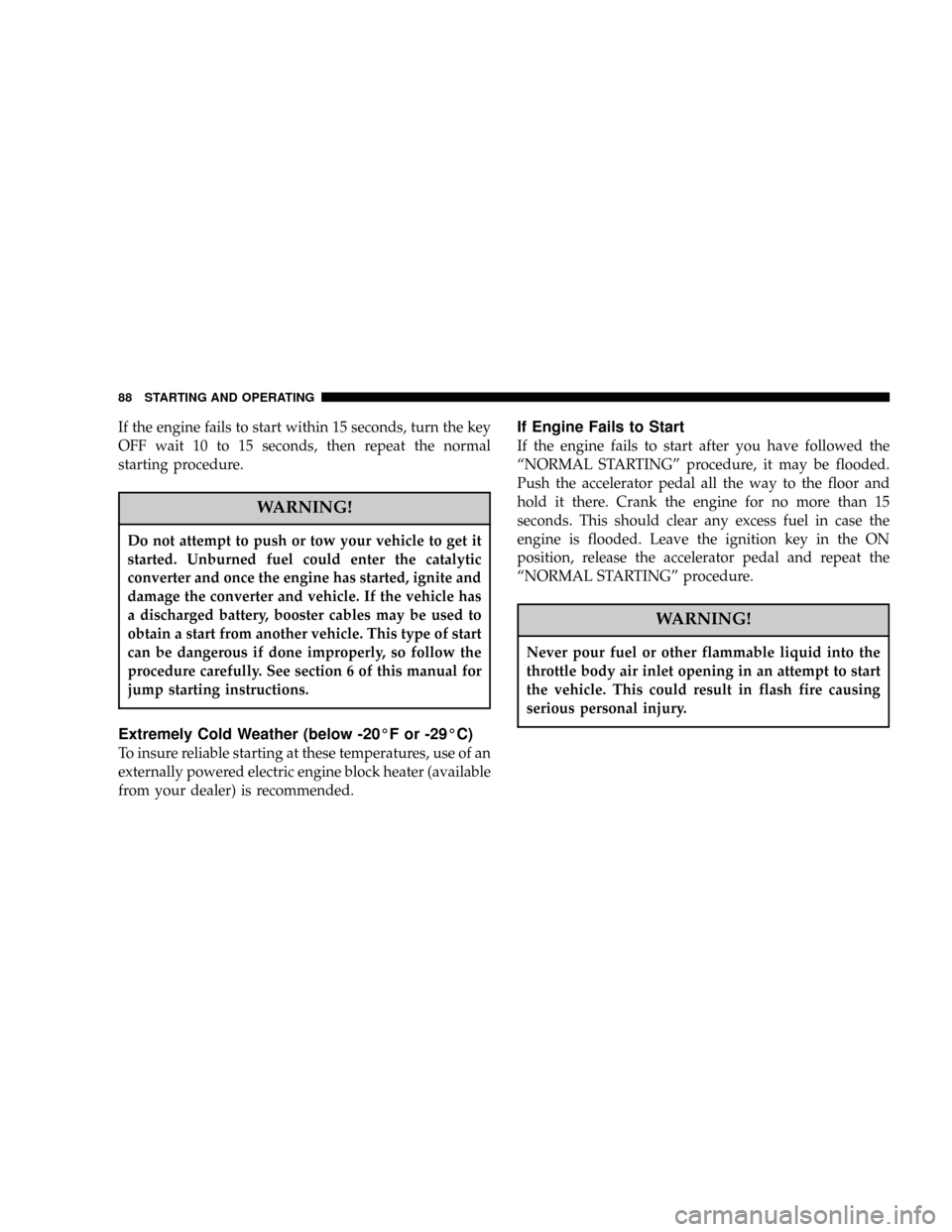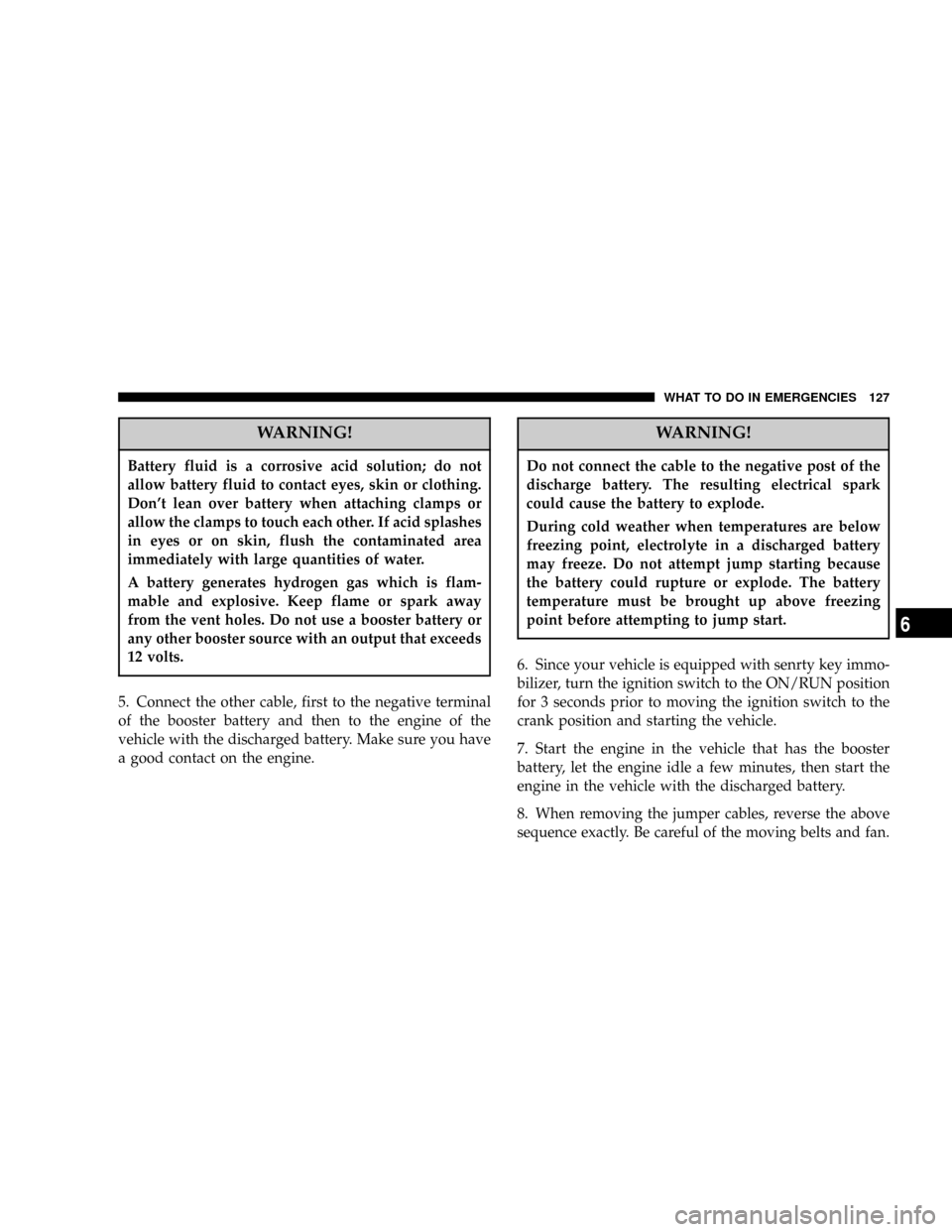2004 DODGE NEON SRT key battery
[x] Cancel search: key batteryPage 88 of 200

If the engine fails to start within 15 seconds, turn the key
OFF wait 10 to 15 seconds, then repeat the normal
starting procedure.
WARNING!
Do not attempt to push or tow your vehicle to get it
started. Unburned fuel could enter the catalytic
converter and once the engine has started, ignite and
damage the converter and vehicle. If the vehicle has
a discharged battery, booster cables may be used to
obtain a start from another vehicle. This type of start
can be dangerous if done improperly, so follow the
procedure carefully. See section 6 of this manual for
jump starting instructions.
Extremely Cold Weather (below -20ÉF or -29ÉC)
To insure reliable starting at these temperatures, use of an
externally powered electric engine block heater (available
from your dealer) is recommended.
If Engine Fails to Start
If the engine fails to start after you have followed the
ªNORMAL STARTINGº procedure, it may be flooded.
Push the accelerator pedal all the way to the floor and
hold it there. Crank the engine for no more than 15
seconds. This should clear any excess fuel in case the
engine is flooded. Leave the ignition key in the ON
position, release the accelerator pedal and repeat the
ªNORMAL STARTINGº procedure.
WARNING!
Never pour fuel or other flammable liquid into the
throttle body air inlet opening in an attempt to start
the vehicle. This could result in flash fire causing
serious personal injury.
88 STARTING AND OPERATING
Page 119 of 200

WHAT TO DO IN EMERGENCIES
CONTENTS
mHazard Warning Flasher.................120
mIf Your Engine Overheats................120
mJacking And Tire Changing...............122
NPreparations For Jacking................122
NInstructions.........................122
mJump-Starting Procedures Due To A Low
Battery
..............................125
mDriving On Slippery Surfaces.............128
NAcceleration.........................128NTraction............................128
mFreeing A Stuck Vehicle.................129
mTowing A Disabled Vehicle...............130
NWith Ignition Key.....................130
NWithout The Ignition Key...............130
NTowing This Vehicle Behind Another Vehicle
(Flat Towing With All Four Wheels On The
Ground)............................130
6
Page 120 of 200

HAZARD WARNING FLASHER
The flasher switch is on top of the steering column,
just behind the steering wheel. Depress the switch
and both cluster indicators and all front and rear direc-
tional signals will flash. Depress the switch again to turn
Hazard Warning Flashers off.
Do not use this emergency warning system when the
vehicle is in motion. Use it when your vehicle is disabled
and is creating a safety hazard for other motorists.If it is necessary to leave the vehicle to go for service, the
flasher system will continue to operate with the ignition
key removed and the vehicle locked.
NOTE:With extended use, the flasher may wear down
your battery.
IF YOUR ENGINE OVERHEATS
In any of the following situations, you can reduce the
potential for overheating by taking the appropriate ac-
tion.
²On the highways Ð Slow down.
²In city traffic Ð While stopped, put transaxle in
neutral, but do not increase engine idle speed.
NOTE:There are steps that you can take to slow down
an impending overheat condition. If your air conditioner
is on, turn it off. The air conditioning system adds heat to
the engine cooling system and turning off the A/C
removes this heat. You can also turn the Temperature
control to maximum heat, the Mode control to floor, and
120 WHAT TO DO IN EMERGENCIES
Page 127 of 200

WARNING!
Battery fluid is a corrosive acid solution; do not
allow battery fluid to contact eyes, skin or clothing.
Don't lean over battery when attaching clamps or
allow the clamps to touch each other. If acid splashes
in eyes or on skin, flush the contaminated area
immediately with large quantities of water.
A battery generates hydrogen gas which is flam-
mable and explosive. Keep flame or spark away
from the vent holes. Do not use a booster battery or
any other booster source with an output that exceeds
12 volts.
5. Connect the other cable, first to the negative terminal
of the booster battery and then to the engine of the
vehicle with the discharged battery. Make sure you have
a good contact on the engine.
WARNING!
Do not connect the cable to the negative post of the
discharge battery. The resulting electrical spark
could cause the battery to explode.
During cold weather when temperatures are below
freezing point, electrolyte in a discharged battery
may freeze. Do not attempt jump starting because
the battery could rupture or explode. The battery
temperature must be brought up above freezing
point before attempting to jump start.
6. Since your vehicle is equipped with senrty key immo-
bilizer, turn the ignition switch to the ON/RUN position
for 3 seconds prior to moving the ignition switch to the
crank position and starting the vehicle.
7. Start the engine in the vehicle that has the booster
battery, let the engine idle a few minutes, then start the
engine in the vehicle with the discharged battery.
8. When removing the jumper cables, reverse the above
sequence exactly. Be careful of the moving belts and fan.
WHAT TO DO IN EMERGENCIES 127
6
Page 135 of 200

Normally, the OBD system will be ready. The OBD
system maynotbe ready if your vehicle was recently
serviced, if you recently had a dead battery, or a battery
replacement. If the OBD system should be determined
not ready for the I/M test, your vehicle may fail the test.
Your vehicle has a simple ignition key actuated test
which you can use prior to going to the test station. To
check if your vehicle's OBD system is ready, you must do
the following:
1. Insert your ignition key into the ignition switch.
2. Turn the ignition to the ON position, but do not crank
or start the engine.
3. If you crank or start the engine, you will have to start
this test over.
4. As soon as you turn your key to the ON position, you
will see your MIL symbol come on as part of a normal
bulb check.
5. Approximately 15 seconds later, one of two things will
happen:a. The MIL will flash for about 10 seconds and then
return to being fully illuminated until you turn off
the ignition key or start the engine. This means that
your vehicle's OBD system isnot readyand you
shouldnotproceed to the I/M station.
b. The MIL will not flash at all and will remain fully
illuminated until you turn off the ignition key or
start the engine. This means that your vehicle's OBD
system isreadyand you can proceed to the I/M
station.
If your OBD system isnot ready,you should see your
authorized dealer or repair facility. If your vehicle was
recently serviced or had a battery failure or replacement,
you may need to do nothing more than drive your
vehicle as you normally would in order for your OBD
system to update. A recheck with the above test routine
may then indicate that the system is now ready.
Regardless of whether your vehicle's OBD system is
ready or not ready, if the MIL symbol is illuminated
during normal vehicle operation, you should have your
MAINTAINING YOUR VEHICLE 135
7
Page 192 of 200

ABS (Anti-Lock Brake) System.............. 94
Adding Engine Coolant (Antifreeze)......... 150
Adding Fuel........................... 116
Air Cleaner, Engine..................... 142
Air Conditioning.....................78,144
Air Conditioning Controls................. 78
Air Conditioning Refrigerant.............. 144
Air Conditioning System................. 144
Air Pressure, Tires...................... 105
Airbag................................ 27
Airbag Deployment...................... 33
Airbag Light.......................35,44,65
Airbag Maintenance...................... 35
Airbag, Side........................... 34
Alarm, Panic........................... 17
Alarm System.......................... 65
Alignment and Balance.................. 110
Alterations/Modifications, Vehicle............ 6
Antenna, Satellite Radio................... 76
Antifreeze (Engine Coolant)............165,166
Anti-Lock Brake System................... 94
Anti-Lock Warning Light.................. 63
Appearance Care....................... 155Ashtrays and Lighter..................... 58
Automatic Door Locks.................... 13
Ball Joints............................ 145
Battery............................... 142
Keyless Transmitter Replacement.......... 18
Belts, Drive........................... 140
Belts, Engine.......................... 142
Body Mechanism Lubrication.............. 145
B-Pillar Location....................... 100
Brake Fluid........................... 166
Brake, Parking.......................... 92
Brake System........................94,153
Anti-Lock............................ 94
Hoses.............................. 153
Master Cylinder...................... 154
Parking............................. 92
Warning Light........................ 63
Break-In Recommendations, New Vehicle...... 42
Bulb Replacement...................162,163
Caps, Filler
Fuel............................... 116
192 INDEX
Page 196 of 200

Keyless Entry System..................... 16
Keys.................................. 9
Lane Change and Turn Signals.............. 64
Lap/Shoulder Belts...................... 20
Lead Free Gasoline...................... 113
Leaks, Fluid............................ 44
Light Bulbs........................162,163
Lighter, Cigar.......................... 58
Lights................................ 52
Airbag..........................35,44,65
Anti-Lock............................ 63
Brake Warning........................ 63
Center Mounted Stop.................. 164
Daytime Running...................... 54
Dimmer Switch, Headlight.............53,55
Dome............................... 53
Exterior Check........................ 44
Fog ................................ 54
Headlights On Reminder................ 54
High Beam Indicator................... 64
Instrument Cluster..................... 54
Lights On Reminder.................... 54Malfunction Indicator................... 66
Map Reading......................... 52
Oil Pressure.......................... 64
Park................................ 54
Passing............................. 55
Rear Servicing....................... 164
Rear Tail............................ 164
Seat Belt Reminder..................... 65
Side Marker......................... 164
Theft Alarm.......................... 65
Turn Signal.....................55,64,164
Voltage.............................. 65
Loading Vehicle........................ 117
Tires ............................... 100
Locks................................ 12
Child Protection....................... 14
Door............................... 12
Ignition............................ 134
Power Door.......................... 13
Steering Wheel........................ 12
Lubrication, Body....................... 145
Maintenance Free Battery................. 142
196 INDEX